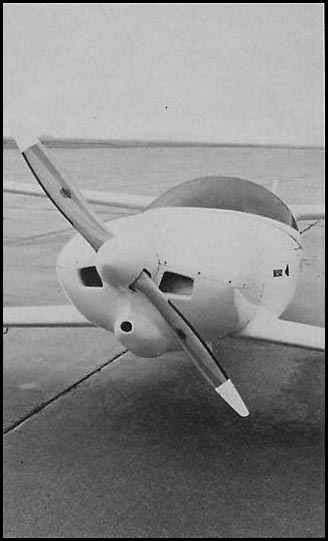Homebuilt Aircraft - March 1984
- Details
- Category: Magazine Articles
- Published: Monday, 19 April 2010 01:31
- Written by Bill Cox
- Hits: 17035
QUICKER QUICKIE
Sporting a O-200 Continental and a new canard airfoil, Quickie Aircraft's new Q-200 is a change for the better with improved performance and drastically reduced airfoil contamination problems
By Bill Cox
Take one of the fastest and most efficient homebuilt airplanes, increase the horsepower by 50 percent, and what have you got? A faster and even more efficient example of homebuilt technology that will figuratively blow the doors off any comparably powered model.
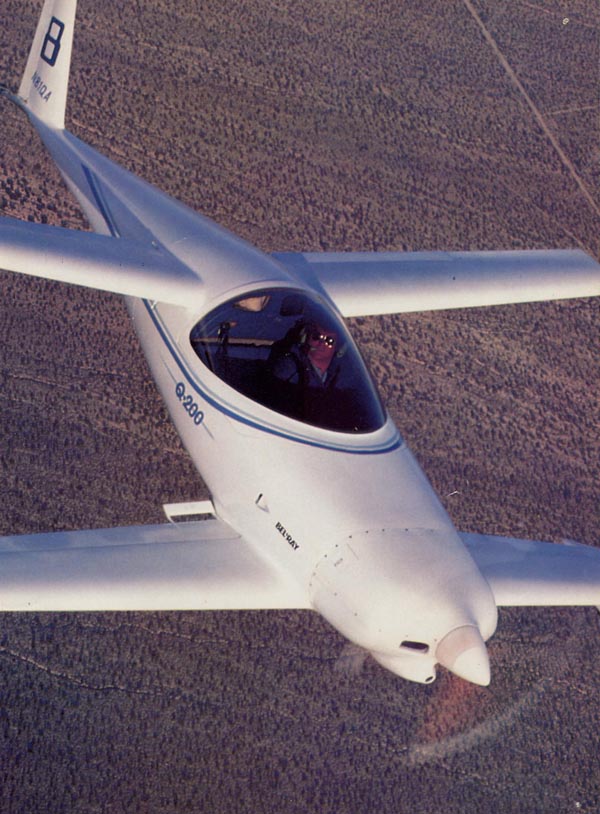
Quickie Aircraft's two-model line of futuristic homebuilts has long been considered among the best of the build-it-in-your-garage designs. As a result of an extremely low drag coefficient and minimal flat-plate area, the Quickie and two-place Q-2 offer excellent cruise speed on little horsepower.
Now, Quickie has come up with what may be its ultimate two-place design, the Q-200. While the "old" Q-2 used a 60-to 65-hp VW Revmaster conversion for power, the Q-200's motive force is an O-200 Continental, the exact mill that provided incentive for the Cessna 150. In the Cessna application the Continental was chosen more for reliability than power; no one would ever consider a Q-200 and a Cessna 150 to be in the same performance class, but it's still interesting to compare the two airplanes.
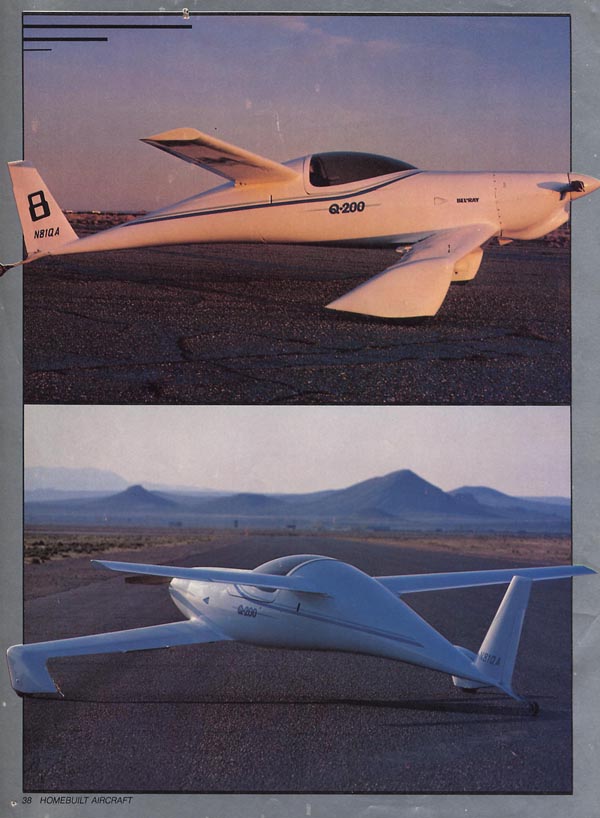
Quickie's newest effort is 500 pounds lighter (1100 pounds gross compared to the 150's 1600 pounds), but more importantly, effective flat-plate area for the Q-200 is about the same as that of the Cessna's landing gear. (EFPA is a measure of total aircraft drag translated to a single, square, flat plate being pushed through the air. The greater the area, the greater the drag. On the Q-200, EFPA is a mere 1.35 sq.ft.) Understandably, such superior aerodynamics, combined with 30 percent less weight, have some dramatic effects on performance.
As with any power upgrade, you don't simply drop in a larger engine and fly away with it. Bigger powerplants are nearly always heavier, but they also generate higher airframe weight because of the design changes necessary to accommodate more power. Although the Continental O-200 weighed only about 25 pounds more than the Revmaster it replaced, total empty weight of the Q-2 was increased by 50 pounds in the Q-200 application. More weight out front meant a more forward CG, so the main gear was moved forward three inches to place slightly more of the aircraft weight aft and maintain an acceptable balance point.
The extra weight also gave the folks at Quickie an excuse to modify the wing. The goals were not only to increase overall efficiency, but to make the airplane more forgiving of surface contamination. Canard designs have long been known to suffer some degradation of lift in light rain or with a coating of bugs on the leading edge, and for that reason, the Q-2's Glasgow University GU25-5(11)8 airfoil was replaced by a comparatively new (1981) section known as the NASA LS(1)-0417 MOD.
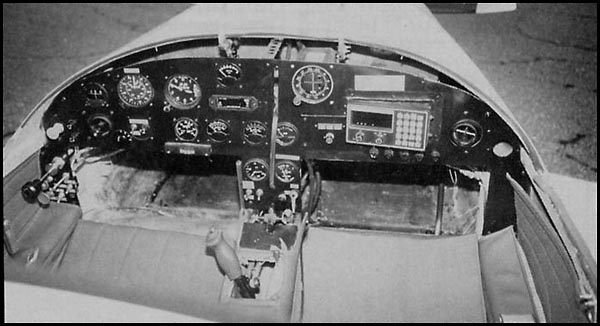
Without discussing the aerodynamics involved, the new wing provides greater lift with slightly less drag, although airfoil surface remains the same as the GU wing — 67 sq.ft.
One result of more horsepower is a higher gross weight. The folks at Quickie elected to offer Q-200 builders a slight improvement in useful load by upping the gross 100 pounds. Considering that empty weight increased only about 40 to 50 pounds, this means that you'll realize at least 50 pounds more useful load. The Q-200's top weight is 1100 pounds compared to the Q-2 's 1000 pounds. (On Q-2s equipped with the new wing, the gross weight is also 1100 pounds.)
Despite the new airplane's Star Wars appearance, it is, at least in a few respects, a conventional aircraft. It's a taildragger with a fixed-pitch prop and fixed gear. It's also a biplane that employs negative stagger (similar to the 1930s' vintage Beech). For those who think canards area new, exciting innovation, the first canard appeared on the Wright Flyer of 1903.
To find out more about the Q-200 phenomenon, senior editor Bill Cox, contributing photographer Chris Mullen and I went to Quickie's Mojave, Calif, plant to visit with company president Gene Shee-han and fly the prototype Q-200. As usual, Cox won the toss to fly the airplane. His report follows.
—Douglas Colby
The black clouds of winter hugged the tan/green mountains to the west, light gray streaks of rain connecting them to the desert floor. Five thousand feet above, the sky raced by at 50 knots, angry stratus eager to reach Nevada. Strong surface winds stood the sock out straight as a Mormon, pushing sand and an occasional tumbleweed skittering across the ramp.
I had flown the 60 miles north from Los Angeles to fly Quickie's newest wonderplane, the Q-200. Unfortunately, the weather wasn't cooperating. Despite past experience in half a dozen other canard designs (including the Q-2) and time in some truly squirrely taildraggers such as the Pitts, I wasn't anxious to try on the Q-200 in such gusty wind conditions.
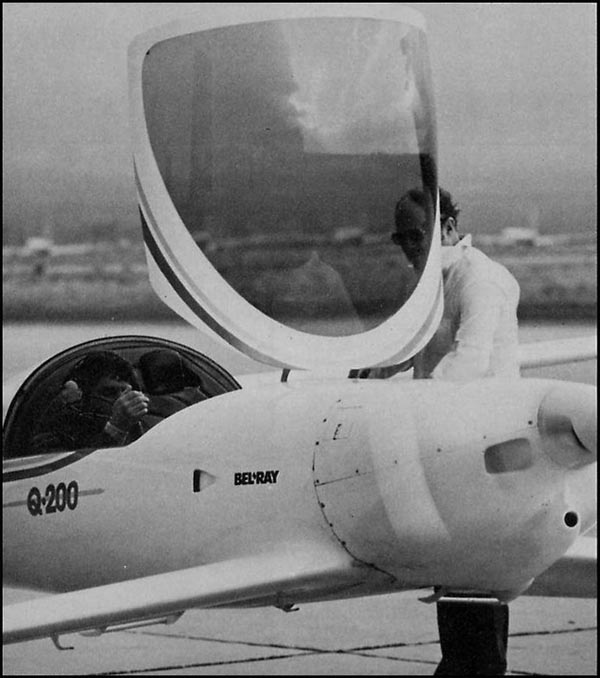 |
|
Quickie's side-by-side positions pilot and passengers in a semi-supine configuration. |
Unfortunately, time and editorial deadlines wait for no man. Quickie's Gene Sheehan had managed to wrestle the Q-200 around the pattern for a quick test flight, after which he pronounced both me and the airplane airworthy.
Climbing aboard the Q-200 isn't difficult, but it's still the toughest aspect of operating the airplane. Like most self-respecting composite designs, the Q-200 has no doors. The wide, clear, plexiglass hatch hinges at the front and folds straight up (a consideration if you're faced into the wind). Resisting the temptation to step on the elevator anti-servo trim tab, you lift your leg over the fuselage sidewall and step down onto the pilot's seat. As you settle into the nearly supine seating position, your legs fit straight out in front of you into a rather confining compartment beneath the instrument panel. Once you've put the airplane on and strapped in, you'll find the seating position comfortable. There's precious little room to shift your position. My time in the airplane was limited to about three hours in four separate flights, and I'm glad I didn't have to spend it all at one sitting.
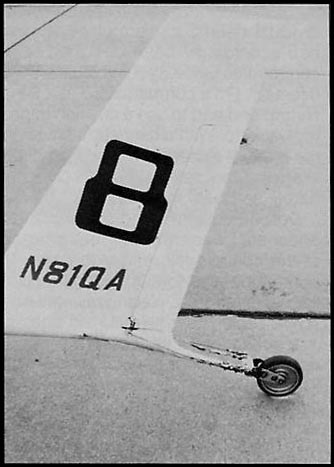 |
|
Rudder power on the Q-200 is unusually effective in |
No matter what your height is nor how long you must fly, forward visibility on the ground is limited by the fast sweep of the canopy, which fairs smoothly with the cowling. Because the Q-200 is a homebuilt, you can build the seat to fit your in-dividual needs; the prototype airplane had accordingly been designed to accommodate Gene Sheehan at more than 6 feet tall. I'm a comparative 5-foot 9-inch shrimp and had to use a cushion to prop my back up. With a headset in place and the canopy closed, my head was directly against the plexiglass,and I could just barely see over the nose.
Despite custom fitting the airplane to Sheehan, I was surprised that almost all of the controls fell readily to hand. My right elbow and forearm fell naturally to the center armrest, placing my right hand on the center, console-mounted sidestick. Just forward of the stick is the aileron reflex control, close enough to brush your knuckles if you're maneuvering the airplane. Forward of that is the elevator trim wheel and fuel transfer pump.
On the opposite side my left hand came to rest on the handbrake, which is within inches of the throttle. Standard, push-pull-style mixture and carb heat controls are conveniently within reach below along with the master and mag switches.
Engine start is standard O-200. The starter had been removed to save weight for the Lowers-Baker-Falck competition at Oshkosh 1983. Sheehan pulled the prop through several times; I gave the throttle one pump and the engine caught on the next blade.
Taxiing the Q-200 is about as easy as any taildragger I've flown. The rudder pedals are directly connected to the tailwheel, and even though there's no asymmetric brake system, directional control is excellent, even in stiff winds. Sheehan said that he'd tried several asymmetric brake systems on the airplane but that because the wheels are located so far out on the canard, any uneven application of brakes, whether intended or not, can result in a nearly uncontrollable swerve. For the time being the Q-200 will stick with a single handbrake that will apply equal braking to both main gear.
The Q-200 is built so close to the ground that wind has little effect on it during taxiing. Because both the hand brake and throttle are located on the left, you can only work one at a time, but braking is hardly needed if you keep taxi speeds low.
I tried hard turns at speeds of up to about 10 to 15 mph on the ground to see where the Q-200's steering limits were and had no trouble recovering to straight ahead. The airplane goes where you point it with a minimum of fuss, and the rudder pedals provide immediate and positive control. As mentioned earlier, over-the-nose visibility isn't the best, but the Q-200's extremely low profile and three-point attitude allow just enough of a look forward so there's no need to S-turn.
Run-up is again as uncomplicated as possible. Each mag has its own switch, and rpm drop should be 50 or less. Every student educated in a Cessna 150 should be familiar with the Continental Q-200's
tendency to accumulate carburetor ice. The carburetor's position and design make it prone to icing, and it's therefore advisable to use plenty of carb heat on the ground and in flight in the Q-200 when conditions are right for ice.
One fine point about the Q-200's fuel system: The electric pump mounted on the panel is not intended as a fuel pump in the conventional sense. It's not designed to restore fuel pressure to the engine. Rather, its function is to transfer fuel from the main, 14-gallon fuselage tank to the six-gallon header tank directly behind the engine. The Continental burns fuel from the header tank only, so you must keep that tank full. On the prototype, a clear, plastic tube indicates header tank level. When the level drops in the tube, you must pump fuel from the main to the header or simply leave the pump on all the time.
On the first day of my flights, the wind never dropped below 20 knots, but the Quickie wasn't nearly as much of a handful as I'd expected. Despite the wide gear that tended to emphasize any wind gust, the tailwheel steering at low speeds and the rudder at higher velocities were so powerful that the airplane never even came close to getting out of hand. Ground loops might be possible but you'd have to work at it to get the airplane mad at you.
On takeoff the Q-200 unstuck at about 65 to 70 mph, and after a short pause to catch its breath and accelerate to 110 mph, I started uphill at what I guessed to be more than 1000 fpm. (Later, I timed a climb from 3000 to 5000 feet and recorded right at 1100 fpm. I'd suspect that vertical performance would bleed off quite a bit with two people aboard the airplane.)
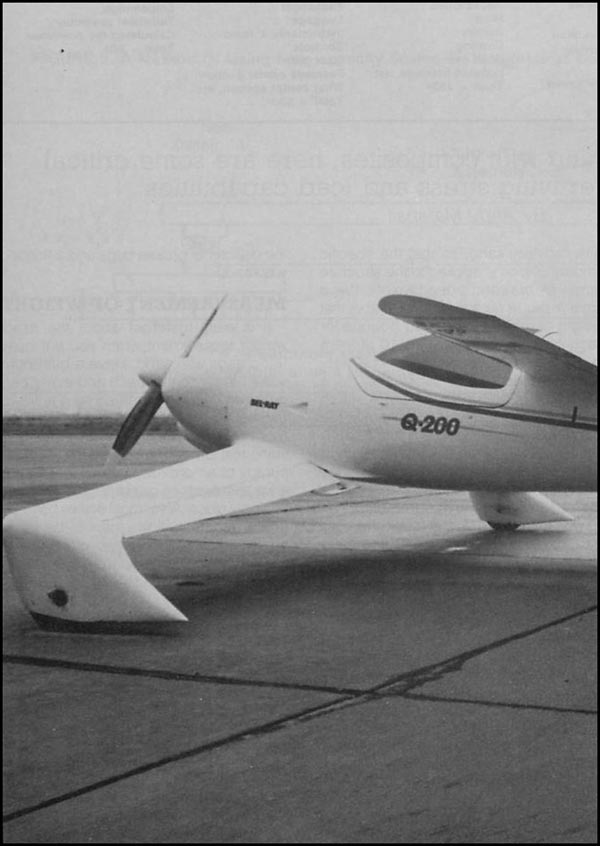 |
|
The combination of wide gear and low CG gives the Q-200 good ground-handling |
It was immediately obvious that control sensitivity was far better than on any other canard design that I'd flown. The side stick is extremely responsive, some pilots might even feel too much so, requiring only a slight twist of your right wrist to pitch or roll the airplane. Personally, I've always been a fan of quick controls and found the Q-200's fast response to be great fun.
In fact, on a later flight when I was more accustomed to control response, I tried a few aileron rolls left and right. The Q-200 made a full rotation in five to six seconds for a roll rate of at least 60 degrees per second. Loops would probably be a little less friendly. While there's enough canard response to get the airplane over the top, the trip down the back side could be a fast one indeed. Put the nose down on the Q-200. and it picks up speed right now. Drop the nose to vertical, and I'd bet you'd see a surprisin0 speed buildup and commensurate altitude loss. For this reason, I didn't try loops, whichis just as well, as Quickie doesn't suggest aero in the Q-200 anyway.
|
|
|
Quickie's newest two-place uses a 100-hp |
Published load limits, by the way, are 4.4 G's, although the combination landing gear/canard has been tested to over 30 G's. A Q-200 isn't likely to come apart in the air, but there's a good chance it would if you dove it into the ground.
Level at 7500 feet above Mojave on a standard day, I left the power to the wall to see what kind of cruise the airplane could deliver at 75 percent power. It took a while for the newest Quickie to accelerate up to max speed, but eventually I saw 169 mph indicated for 194 mph true, this considering that I was probably burning only about 6.5 gph. Later, to verify the speed I timed a pair of max throttle low passes above the full 9610 feet of runway 12/30 at Mojave and came up with an average time of 33.8 seconds. By an interesting coincidence, that's exactly 194 mph.
With this kind of performance on tap, there's little question that the Q-200 is one of the most efficient airplanes in the sky. Reduced power settings obviously would yield better economy, but it's refreshing to know that even at max cruise, you can fly nearly 30 miles on a gallon of auto gas.
At the opposite end of the speed envelope, the Q-200 is typical canard. Stalls are so docile as to be virtually nonexistent. Hold the yoke full back with
the power off and the Q-200 will merely buck up and down, hobby-horse style. According to the specification chart, stall speed is 64 mph, but the airspeed is virtually off the bottom of the gauge during the seesaw stall.
I'd heard quite a bit about canard problems in the rain, and had a chance to investigate the Q-200's response on the first day of my flights. I deliberately aimed the airplane beneath a massive black cloud and flew through a light but continuous spray of misty rain, allegedly the worst possible condition for a canard. I'd been told that other canard airfoils pitch down slightly under these conditions, but the Q-200 apparently hadn't read the same reports. The airplane drove right through the wet with no apparent reaction, oblivious to its supposed bad manners. The new NASA airfoil is obviously a major improvement.
Back in the pattern for landing, I first tried 100 mph over the fence and found that to be far too much speed. Characteristic of most extremely clean designs, the Q-200 takes a while to slow down and doesn't really like to fly slowly. Handling is adequate at low airspeeds, but the airplane is much happier at higher speeds. Eventually, I worked approach speed down to 85 to 90 mph and wound up with rollouts of a few thousand feet. The Q-200 definitely is not a short-field airplane.
Touchdowns are reasonably simple as long as you have the landing attitude approximately correct. Once on the ground the Q-200 has little tendency to seek back and forth or go darting off on excursions through the runway lights. The rudder pedals provide instant correction of any slight heading change. In short, it's an easy taildragger to land.
It's also an easy airplane to build, according to friends who've put together Q-2s. Sheehan suggests that most builders should complete the airplane in about 600 to 800 hours, but some will run to 1000 hours or more. The complete kit costs less than $10,000, less engine, prop and instruments. Plan to spend another $10,000 for the latter items and you'll have a near-200 mph, two-place traveling machine for a total investment of $20,000.
There's little question that Quickie has come up with a winner in the Q-200. The airplane is faster than it has any right to be. Fuel efficiency is excellent and the airplane can carry two people plus full fuel without straining. If I had an extra 20 grand, I'd certainly consider a Q-200, especially considering that you can't buy anything new in general aviation for twice the price.
The Q-200 outperforms them all, and there's every reason to believe that it may supplant the Thorp T-18 Tiger as the world's most popular homebuilt. •
|
||||||




